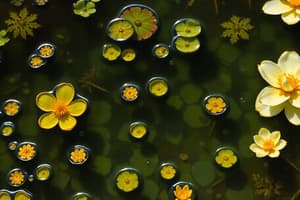Podcast
Questions and Answers
Which zone of freshwater is characterized by warmer temperatures and abundant light?
Which zone of freshwater is characterized by warmer temperatures and abundant light?
- The Limnitic Zone
- The Pelagic Zone
- The Littoral Zone (correct)
- The Benthic Zone
What type of bacteria dominate the Limnitic Zone due to the decrease in oxygen?
What type of bacteria dominate the Limnitic Zone due to the decrease in oxygen?
- Halophilic bacteria
- Purple and green sulfur bacteria (correct)
- Methane-producing bacteria
- Photosynthetic algae
Which of the following microorganisms are commonly found in saltwater environments?
Which of the following microorganisms are commonly found in saltwater environments?
- Staphylococcus
- E.coli
- Halophilic bacteria (correct)
- Green algae
What phenomenon caused by dinoflagellates can turn oceans red and deplete oxygen?
What phenomenon caused by dinoflagellates can turn oceans red and deplete oxygen?
Which type of bacteria is known to dominate the ocean food chain as one of its ancient forms of life?
Which type of bacteria is known to dominate the ocean food chain as one of its ancient forms of life?
In the Benthic Zone of freshwater environments, which type of bacteria thrives?
In the Benthic Zone of freshwater environments, which type of bacteria thrives?
What effect do high salt concentrations and lower nutrient levels have on many microorganisms?
What effect do high salt concentrations and lower nutrient levels have on many microorganisms?
What happens to fish during a red tide caused by dinoflagellates?
What happens to fish during a red tide caused by dinoflagellates?
What is an example of a method to treat drinking water that has been known for centuries?
What is an example of a method to treat drinking water that has been known for centuries?
Which microorganism is associated with life-threatening diarrhea in humans?
Which microorganism is associated with life-threatening diarrhea in humans?
What is the purpose of chlorine or chlorine derivatives in drinking water treatment?
What is the purpose of chlorine or chlorine derivatives in drinking water treatment?
How do modern filtration systems ensure water is safe from microorganisms?
How do modern filtration systems ensure water is safe from microorganisms?
What does measuring the turbidity of water indicate?
What does measuring the turbidity of water indicate?
Which treatment method disables the microbe's genetic material?
Which treatment method disables the microbe's genetic material?
Which of the following is NOT a method mentioned for killing bacteria in drinking water?
Which of the following is NOT a method mentioned for killing bacteria in drinking water?
What is one commonly used method for protecting drinking water that has been known since ancient times?
What is one commonly used method for protecting drinking water that has been known since ancient times?
Study Notes
Fresh Water Microbiology
-
Littoral Zone: The shoreline area that is shallow, well-lit, and warmer. It supports photosynthetic algae and bacteria thriving on light energy.
-
Limnetic Zone: Located further from the shore, where photosynthetic microbes exist. As depth increases, temperature drops, and oxygen and light levels decrease, favoring purple and green sulfur bacteria, which can survive without oxygen.
-
Benthic Zone: The bottom layer of freshwater bodies where few microorganisms survive. Methane-producing bacteria thrive here in the absence of light and oxygen.
Saltwater Microbiology
-
Environmental Challenges: Higher salt concentration, elevated pH, and lower nutrient levels pose challenges for many microorganisms. Halophilic bacteria thrive near the surface despite these conditions.
-
Dominant Microbial Life: Archaebacteria are significant microbial inhabitants of the ocean, although their specific role in the food chain is still not well understood.
-
Dinoflagellates: A type of algae that can rapidly grow, leading to "red tides" that deplete nutrients and oxygen in water, potentially causing fish die-offs and harming humans through contaminated seafood.
Microbial Transport and Safety
-
Microbial Transport: Water in ships' hulls can unintentionally transport microorganisms globally, such as Vibrio cholerae, which causes severe diarrhea in humans.
-
Water Treatment History: The importance of treating drinking water to minimize microbial contamination has been recognized for centuries, with methods evolving over time.
-
Practices in Historical Context:
- Metal jugs for water storage were used in pre-Christian times for their antibacterial properties.
- Boiling water has long been recognized as a method for purification.
Modern Water Treatment Methods
-
Chemical Treatment: Chlorine and its derivatives have been used since the early 1900s to eliminate pathogens like Escherichia coli.
-
Ozone Treatment: Increasingly popular as an effective method for killing bacteria.
-
Ultraviolet Light: This method disables the genetic material of microbes, preventing their replication.
-
Filtration: Modern filtering techniques can exclude microorganisms from water by trapping particles as small as viruses.
Water Quality Testing
- Turbidity Testing: A common method for assessing water quality. Higher turbidity often correlates with the presence of suspended materials, indicating potential microbial contamination.
Studying That Suits You
Use AI to generate personalized quizzes and flashcards to suit your learning preferences.
Description
Explore the fascinating world of microorganisms in fresh water, focusing on the littoral zone. This well-lit, shallow area near shorelines supports diverse photosynthetic algae and bacteria that thrive in warmer conditions. Learn about the roles these microorganisms play in freshwater ecosystems.




